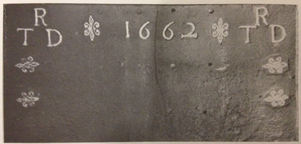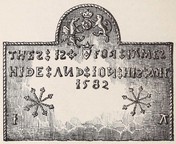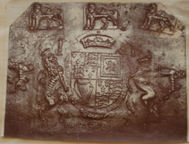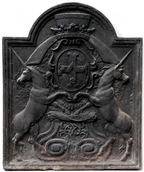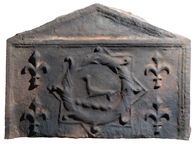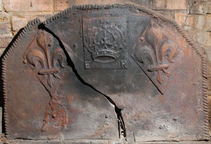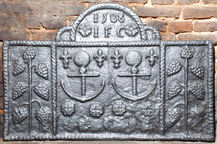-
964
Description: Rectangular; Twisted rope edging (top and sides); top centre, date; initials in triad in top corners; a double fleurs-de-lys between date and each set of initials, and two rotated down each side of the plate.
Notes: Formerly at a cottage in Bradford's Lane, Newent, Gloucestershire. Illustration from Bick 1987.
Inscription: TRD / 1662 / TRD
- Decoration tags:
- rectangular (shape)
- rope (edging)
- carved stamps
- individual letters
- individual numbers
- heraldic
- text
Manufactured: in 1662 in the Forest of Dean area of England.
Current location: The Glasshouse Inn, May Hill, Longhope, Gloucestershire, England.
Citation: Bick, D. E., 1987, The Mines of Newent and Ross, (Newent, The Pound House), p. 35.
- Attached to series:
- Date & initials firebacks
-
473
Description: Arched rectangular shape; twisted rope edging (top and sides); in arch; rose and crown with dragon and lion supporters, above a fleur cross and a crowned shield bearing a small fleur-de-lys; text across top half, each word separated by two fleur terminals; lower left and right, twice repeated eight-pointed star design formed of twisted rope with fleur-de-lys terminals; bottom left, ‘I’; bottom right, ‘A’.
Notes: A James Hide married Joan Blackefane at Horley, Surrey on 11th October 1579; illustrated in Lower, 1849 p. 217, when it was at Sutton Hurst, Barcombe, Sussex (still there in 1893, house since demolished). One of a small series of distinctive firebacks cast in 1582, most with inscriptions dedicated to pairs of individuals; the initials IA may be of the founder as they appear in the same arrangement on other firebacks.
Inscription: THES : IS FOR IAMES : / HIDE : AND : ION : HIS : WIF [W inverted] / 1582 / I A
- Decoration tags:
- rectangular with round arch (shape)
- rope (edging)
- carved stamps
- individual letters
- individual numbers
- heraldic
- text
- objects
Manufactured: in 1582 possibly at Pounsley Furnace, Framfield in the Weald area of England.
Current location: not known.
- Attached to series:
- Pounsley series
- 1582 IA series
- Fleur rope terminal series
-
864
Description: Canted rectangle; double fillet edging (top and sides); top centre, date; initials in triad, repeated on each side, with a fleur-de-lys between; three fleurs-de-lys evenly spaced below initial groups.
Notes: The initials are believed to be those of Edward Robinson, a bookseller, and his wife of 16 King Street, Ludlow, where the fireback was discovered.
Inscription: 1688 / ERI ERI [both triads]
- Decoration tags:
- rectangular with canted top corners (shape)
- double fillet (edging)
- carved stamps
- individual letters
- individual numbers
- heraldic
- text
Manufactured: in 1688 possibly in the Shropshire area of England.
Current location: Ludlow Museum. The Buttercross, Ludlow, Shropshire, England.
(part of the Ludlow Museum museum group)
Citation: Moran, M., 2003, Vernacular Buildings of Shropshire (Almeley, Logaston Press).
- Attached to series:
- Ludlow series
- Date & initials firebacks
-
1036
Description: Canted rectangular shape; no edging; lower centre, carved pattern panel of Stuart Royal arms: shield, garter, crown, motto, supporters and initials, RI separated by crown; lion statant guardant stamp repeated five times, three across top, one each side feet to left.
Notes: The impression of the decorative elements is irregular, with the achievement of arms under-pressed and the three lion stamps along the top over-pressed; the distinctive feature of the unicorn's horn in front of the initial R has been seen on a small number of other firebacks. From a photograph in the J. Starkie Gardner Collection, Victoria & Albert Museum, Archive of Art and Design (AAD/2014/8).
Inscription: I R
Arms: English Stuart royal - James I
- Decoration tags:
- rectangular with canted top corners (shape)
- none (edging)
- carved stamps
- carved pattern panels
- heraldic
- armorial
- royal
- text
- animals
Manufactured: in the early-17th century possibly in the Weald area of England.
Current location: Maidstone Museum, St Faith's Street, Maidstone, Kent, England.
(part of the Maidstone Museum museum group)
-
1045
Description: Arched rectangular shape; ovolo-moulded edging; top centre, oval shield of arms within a cartouche, supported by two unicorns rampant reguardant, their hooves resting on a scrolled compartment; behind the shield is the cape of the Président à mortier of the Parliament; above the shield, a velvet cap or mortar board of office within a coronet.
Notes: Blazon: azure, on a maltese cross argent a chevron gules between two mullets sable, and in base a rose gules. Louis-Michel Lepeletier, Marquis de Saint-Fargeau (1760-93) was a French parliamentarian. Having voted for the execution of Louis XVI Lepeletier was assassinated by a former guard of the king. The fireback dates from 1789 or later when Lepeletier was elected Président à mortier.
Arms: Louis-Michel Lepeletier, Marquis de Saint-Fargeau
- Decoration tags:
- rectangular with round arch (shape)
- ovolo (edging)
- whole carved pattern
- heraldic
- armorial
Manufactured: in the late-18th century in France.
Current location: 120 Rue de Rosiers, Saint Ouen, Seine-Saint-Denis, France.
- Attached to series:
- Foreign armorial firebacks
-
1040
Description: Rectangular; faux-ruche cavetto-moulded edging; upper centre, shield, helm, crest, mantling and greyhound supporters on a compartment; behind the arms is what appears to be a gown spread out, comprising bands of ermine.
Notes: Blazon: Azure, a bull passant or. Jean Bouhier de Savigny (1673-1746) was President of the Parliament of Burgundy from 1704. He was also a historian, translator, scholar and bibliophile. He resigned his post in Parliament in 1728 to devote himself to his historical and literary work following his election to the French Academy in 1727.
Arms: Jean Bouhier de Savigny
- Decoration tags:
- rectangular (shape)
- faux ruche (edging)
- whole carved pattern
- heraldic
- armorial
Manufactured: in the early- to mid-18th century in France.
Current location: not known.
Citation: Carpentier, H., 1912, Plaques de Cheminées (Paris, published by the author).
- Attached to series:
- Foreign armorial firebacks
-
970
Description: Canted rectangle; twisted rope edging; date along the top; initials in triad across the middle, inside canted rectangular rope border; fleur-de-lys stamp repeated five times down each side.
Notes: The initials probably represent those of a married couple, the 'V' for their surname; it is relatively unusual for twisted rope edging to continue along the bottom of the plate. The back was found in Massachusetts and may have been brought there by an early colonist.
Inscription: 1626 / MVS
- Decoration tags:
- rectangular with canted top corners (shape)
- rope (edging)
- simple stamps
- carved stamps
- individual letters
- individual numbers
- heraldic
- text
Manufactured: in 1626 in the Forest of Dean area of England.
Current location: in private hands, Herndon, Virginia, United States of America.
- Attached to series:
- Date & initials firebacks
- 1620s Dean series
-
672
Description: Rectangular with pediment; ovolo moulded edging inside top of pediment and inside top and sides of rectangle; central talbot crest within wreath and eight-pointed star, between four fleurs-de-lys.
Notes: The wreath and talbot crest are identical to those on a 1584 fireback in the Victoria & Albert Museum; one of the ‘Royal’ series.
- Decoration tags:
- triangular arched (shape)
- ovolo (edging)
- carved stamps
- heraldic
- animals
Manufactured: in the late-16th century in the Weald area of England.
Current location: Middle House Hotel, High Street, Mayfield, East Sussex, England.
- Attached to series:
- Royal series
- Royal (wreath) series
-
486
Description: Rectangular with 5-facetted arch; twisted rope edging; centre top, rectangular stamp, over-pressed, with crown above initials in bottom corners; diamond shaped stamp with fleur-de-lys repeated each side of crown, both over-pressed; spillage blemish below left fleur.
Notes: Notable for the large size of the fleur-de-lys stamp; this casting differs from another (no. 1164) in the placement of the stamps.
Inscription: E R
- Decoration tags:
- multi-facet arched (shape)
- rope (edging)
- carved stamps
- heraldic
- royal
Manufactured: in the mid- to late-16th century in the Weald area of England.
Current location: in private hands, Mayfield, East Sussex, England.
- Attached to series:
- Large diamond fleur series
-
822
Description: Repeated rectangular panels each bearing an anchor with coiled rope between two fleurs de lys, below which are two roses and a grape bunch beneath; the two rectangular side panels each comprise a vertical stem with six grape bunches surmounted by a smaller bunch; above, a semicircular arch contains the initials between two roses as in the central panel, with the date above; where the arch meets the central panel there is an arc across each corner; the top and sides panels are edged with simulated twisted rope.
Notes: One of an unusual series formed from separate panels arranged, in this instance, with each vertical panel repeated.
Copies of this fireback are known.
Inscription: 1588 / IFC
- Decoration tags:
- rectangular with round arch (shape)
- simulated rope (edging)
- carved pattern panels
- heraldic
- text
- plants
- objects
Manufactured: in 1588 in the Weald area of England.
Current location: in private hands, Mayfield, East Sussex, England.
- Attached to series:
- Armada series
